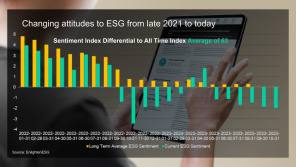

The paper was good, but some parts will need further thought – and like others I have fed in my opinions.
I first became interested in the similarities and differences between sustainable, responsible and ethical funds in 1996, when I moved from what was then NPI to Friends Provident. It was immediately clear to me that the NPI Global Care funds (now the Janus Henderson range) focused more on sustainability, whereas the Friends’ Stewardship fund range (now Aviva) focused more on people.
The strategies were similar. Both catered for "investors who care", but they had slightly different intended audiences.
It was not until I was running the sustainable and responsible investment side at Friends Provident a few years later, when ‘open architecture’ arrived, that I set about bringing different funds onto the Friends’ platform so that we could cater for the widest possible range of client interests.
However, during a meeting with Geoff Mills of RSMR in 2009, after I had left Friends, I realised the fund diversity I found so interesting was not exactly everybody’s cup of tea.
We talked about how useful it would be to put funds into different buckets, with simple labels, so they could be explained to clients more easily. That conversation was the genesis of the SRI Styles on our Fund EcoMarket tool, which launched in 2011.
Much has changed since then. Climate change has become far more evident and scarier, and sustainable investment is now seen as a major investment opportunity.
Given these shifts it has become all the more important sustainable investments are both understandable and trustworthy, which is why I am genuinely delighted the FCA published their sustainability disclosure requirements discussion paper in November.
The paper builds on their excellent ‘Dear Chair’ letter and guiding principles, published last July. The letter set out the regulator’s stance for the "design, delivery and disclosure" of sustainable funds. It also sits alongside numerous related developments, notably increased climate change related, entity level, reporting requirements, which should improve data quality.
DP21/4 is however different as it emphasises clients’ needs.
Disclosures
Starting with disclosures, the paper proposes two tiers of information: a basic level for end clients and more extensive tier for institutional clients. I doubt this will be contentious, although I believe advisers and their clients should have access to all relevant information. Cherry picking access to information can only fuel greenwash fears.
The paper also proposes environmental, social and governance fact sheets. It may be semantics, but the word ‘fact sheet’ bothers me. My preference would be for the regulator to focus on mapping out disclosure requirements, not presentation.
With regard to content, I would suggest leading with the issues a fund focuses on, and mapping them against how it approaches them. Putting these into a simple table – perhaps plotting 'environmental', 'social' and 'sustainable' as columns, and 'avoid', 'invest' and 'influence' in rows (note the use of plain English) should not be hard. The initial text could be a client friendly overview. Information about policies, metrics, methodologies, indices, affiliations and so on would follow.
Some will doubtless want to add 'governance' – and possibly 'ethical' issues – which is fine. My reason for skipping governance is simply because retail clients rarely ask about it, so I would embed it elsewhere. Whatever the system, the aim must be to ensure people understand where funds will and will not invest, and how a manager is working to influence companies through voting and engagement.
I also believe sustainability information must be integrated more widely. Issues like climate change, nature loss and equality are no longer optional bolt-on’s for other business – so why would it be for investors?
As such, sustainability should have a higher profile in all standard literature, training, advice processes and compliance reviews. This may take time to settle, but better conversations and actions will flow if everyone understand the area.
Classifications
Figure three on page 15 of DP21/4 sets out a series of classifications or labels that appear likely to be more contentious. They effectively range from ‘nothing’ to ‘impact’. I am well aware that undertaking an exercise like this is incredibly hard, but a bad-to-best scale feels risky. It can underplay the realities of investing in often complex companies, and does nothing to reflect (much needed) fund diversity and specialisms.
The suggested labels are also ‘very institutional’ and ‘very now’. ‘Transitioning’, ‘aligned’ and ‘impact’ – are useful and popular today – but they are very specific and may not all stand the test of time. They are also neither retail friendly nor watertight. Transitioning and alignment are also very similar. both aim to drive progress.
My suggestion is to split this in two. Use simpler labels; something like 'basic', 'hybrid' and 'sustainability themed', which would loosely map to the EU’s Sustainable Finance Disclosure Regulation classifications, which would help many managers.
Additionally, emphasise the different areas funds focus on – specifically environmental, social and sustainable – perhaps with an illustration along the lines of food labelling (red, amber, green). Deeper explanations would be found in the disclosures document.
These are my personal views. They draw on experience and recent conversations. They are intended as encouragement because how we invest over the next few years really matters.
Through our work we have learned that labels need to be flexible and evolve over time. Our SRI Styles are popular and work, in part, because they are designed for retail intermediaries, focus on issues and do not mention metrics.
However I do not claim to have all the answers. No one does. Hence the value of consultations and committees.
None of this is going to be easy, but being ultra-open, collaborative and realistic is a good place to start.
So, what next?
I suspect the FCA may have a tough time with labels. Language used by data providers and fund managers help their businesses, but are often about as useful as ‘the answer is 42’ to others. We need to find a way through this.
Keeping an eye on real-world outcomes will also be crucial. We know clients are interested (my view is that many always were), so to earn their trust we must meet, or preferably exceed, their reasonable expectations.
That means investee company behaviours must change and emissions must fall. And for that to happen there must be no chinks in the chain. In fact, financial advisers are gently mentioned four times in the discussion paper, but I will leave that for another time.
Julia Dreblow is director of SRI Services and founder of Fund EcoMarket. Dreblow also serves on the new FCA Disclosures and Labels Advisory Group



